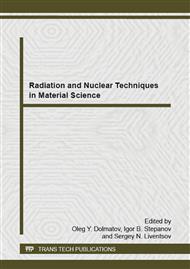[1]
N. Tamaki, K. Morita, Y. Kuge, E. Tsukamoto, The role of fatty acids in cardiac imaging, J Nucl Med. 41 (2000) 1525-1534.
Google Scholar
[2]
F. Knapp, P. Franken, J. Kropp, Cardiac SPECT with iodine-123-labeled fatty acids: evaluation of myocardial viability with BMIPP, J Nucl Med. 36, 6 (1995) 1022-30.
Google Scholar
[3]
T.A. Manolio, K.L. Baughman, R. Rodeheffer, T.A. Pearson, J.D. Bristow, V.V. Michels, W.H. Abelmann, W.R. Harlan, Prevalence and etiology of idiopathic dilated cardiomyopathy (summary of a National Heart, Lung, and Blood Institute workshop), Am J Cardiol. 69 (1992).
DOI: 10.1016/0002-9149(92)90901-a
Google Scholar
[4]
F.A. McAlister, J.A. Ezekowitz, N. Wiebe, B. Rowe, C. Spooner, E. Crumley, L. Hartling, T. Klassen, W. Abraham, Systematic review: cardiac resynchronization in patients with symptomatic heart failure, Ann. Intern. Med. 141. 5 (2004) 381-390.
DOI: 10.7326/0003-4819-141-5-200409070-00101
Google Scholar
[5]
J. Abdulla, J. Haarbo, L. Kober, C. Torp-Pedersen, Impact of implantable defibrillators and resynchronization therapy on outcome in patients with left ventricular dysfunction – a meta-analysis, Cardiology. 106 (2006) 249-255.
DOI: 10.1159/000093234
Google Scholar
[6]
D.J. Bradley, E.A. Bradley, K.L. Baughman, R.D. Berger, H. Calkins, S.N. Goodman, D.A. Kass, N.R. Powe, Cardiac resynchronization and death from progressive heart failure: a metaanalysis of randomized controlled trials, JAMA. 289 (2003) 730-740.
DOI: 10.1001/jama.289.6.730
Google Scholar
[7]
A.A. Sokolov, G.I. Martsinkevich, Electromechanical cardiac asynchronism and heart failure, Cardiologiya (in Russian). 45. 5 (2005) 85-91.
Google Scholar
[8]
C. Leckercq, D.A. Kass, Retiming the failing heart: principles and current clinical status of cardiac resynchronization, J Am Coll Cardiol. 16. 39 (2002) 194-201.
DOI: 10.1016/s0735-1097(01)01747-8
Google Scholar
[9]
W.T. Abraham, D.L. Hayes, Cardiac resynchronization therapy for heart failure, Circulation. 108 (2003) 2596-2603.
DOI: 10.1161/01.cir.0000096580.26969.9a
Google Scholar
[10]
K.V. Zavadovsky, A.N. Pankova, Scintigraphic assessment of the right ventricular dysfunction in patients with cardiac pulmonary thromboembolism, Meditsinskaya vizualizatsiya (in Russian). 3 (2009). 24-30.
Google Scholar
[11]
I. Matsunari, S. Fujino, J. Taki, J. Senma, T. Aoyama, T. Wakasugi, J. Hirai, T. Saga, K. Ichiyanagi, K. Hisada, Impaired fatty acid uptake in ischemic but viable myocardium identified by thallium-201 reinjection, Am Heart J. 131, 3 (1996).
DOI: 10.1016/s0002-8703(96)90523-2
Google Scholar
[12]
N. Inoue, N. Takahashi, T. Ishikawa, S. Sumita, T. Kobayashi, K. Matsushita, K. Matsumoto, M. Taima, M. Shimura, K. Uchino, K. Kimura, T. Inoue, S. Umemura, Reverse perfusion-metabolism mismatch predicts good prognosis in patients undergoing cardiac resynchronization therapy: a pilot study, Circ J. 71, 1 (2007).
DOI: 10.1253/circj.71.126
Google Scholar


